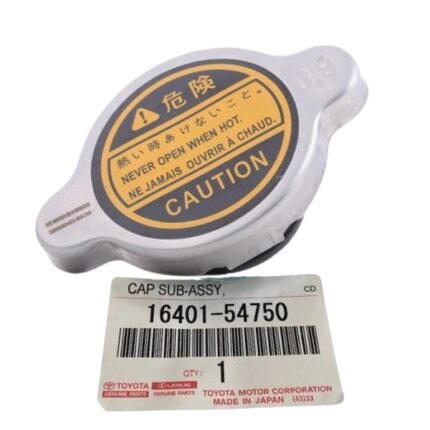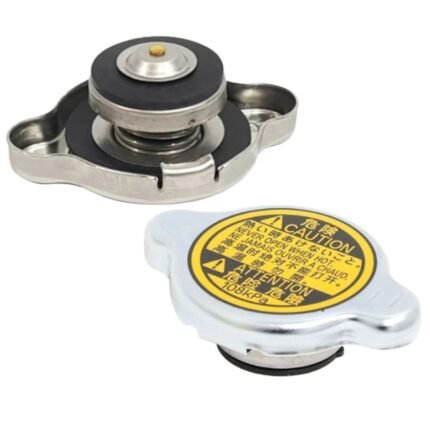Get Genuine Radiator Cap Assy 16401-67150 in Kenya
The Radiator Cap Assembly may appear to be a small and simple component, but it plays a vital role in the overall efficiency, reliability, and safety of a vehicle’s cooling system. Its main purpose is to maintain the correct pressure within the cooling system, ensuring that the engine operates within the optimal temperature range. The radiator cap helps prevent overheating, coolant loss, and air entry, all of which can lead to serious engine damage if not properly controlled. Despite its compact size, the radiator cap is a precisely engineered device designed to handle high pressure and temperature variations under the hood.
1. Function and Working Principle
The radiator cap serves two primary functions: sealing the cooling system and regulating internal pressure. When the engine runs, it generates significant heat. The coolant absorbs this heat and carries it to the radiator, where it is cooled by air passing through the radiator fins. As the coolant heats up, it expands and creates pressure within the system. The radiator cap maintains this pressure at a specific limit—known as the pressure rating—typically between 0.9 to 1.4 bar (13–20 psi) for most vehicles.
When the internal pressure exceeds the cap’s rating, a spring-loaded valve opens, allowing excess coolant to flow into the overflow or expansion tank. As the system cools and pressure drops, the cap’s vacuum valve opens, drawing coolant back into the radiator. This pressure-regulated flow keeps the cooling system sealed, efficient, and free of air pockets.
In simple terms, the radiator cap ensures that the cooling system operates as a closed, pressurized circuit, improving the coolant’s boiling point and preventing fluid loss or overheating.
2. Construction and Components
A radiator cap assembly is built to withstand high heat, pressure, and chemical exposure. Though compact, it consists of several critical parts:
-
Outer Shell (Cap Body): Made from durable metal or reinforced plastic, it provides structure and allows easy grip for removal or tightening.
-
Pressure Valve (Spring-Loaded): This valve opens at a specific pressure to release excess coolant into the expansion tank, maintaining the system’s pressure balance.
-
Vacuum Valve: Allows coolant to return from the overflow tank into the radiator once the system cools down, preventing air entry.
-
Rubber Seals and Gaskets: Ensure a tight seal to prevent leaks and maintain system pressure.
-
Spring Mechanism: Precisely calibrated to handle the correct pressure load; it determines the cap’s pressure rating.
-
Locking Tabs: Secure the cap onto the radiator neck or coolant reservoir, ensuring it remains sealed during operation.
Every part of the radiator cap is crucial—any failure within this small assembly can lead to coolant leaks, air intrusion, and serious overheating problems.
3. Pressure Regulation and Its Importance
One of the most essential features of the radiator cap assembly is its pressure regulation capability. Increasing the system’s pressure raises the boiling point of the coolant. For example, water boils at 100°C under normal atmospheric pressure, but in a sealed system pressurized to about 1.2 bar, the boiling point increases to around 120°C. This allows the coolant to absorb more heat without turning into vapor, preventing overheating even under heavy engine loads or hot weather conditions.
If the radiator cap fails to hold pressure, the coolant may boil prematurely, leading to vapor lock, coolant loss, and reduced heat dissipation. Conversely, if the cap does not release excess pressure, hoses and radiator seals may rupture due to excessive internal force. Thus, the cap’s ability to maintain and relieve pressure precisely is key to the entire cooling system’s performance.
4. Types of Radiator Caps
Radiator caps come in different designs and configurations depending on the vehicle type and cooling system layout:
-
Standard Radiator Cap: Commonly fitted directly on the radiator neck in older vehicles. It controls pressure and allows coolant expansion through a separate overflow tank.
-
Reservoir or Expansion Tank Cap: Found in modern vehicles where the radiator is sealed and the cap sits on a remote expansion tank. It performs the same pressure-regulating functions but within a closed-loop system.
-
Lever-Release Radiator Cap: Includes an additional lever that safely releases pressure before removing the cap, reducing the risk of scalding when checking coolant levels.
Regardless of the design, all radiator caps perform the same fundamental role—keeping the system sealed, pressurized, and balanced.
5. Performance Characteristics
A well-functioning radiator cap assembly offers several performance benefits:
-
Pressure Stability: Maintains optimal pressure for improved cooling efficiency and higher boiling point.
-
Coolant Retention: Prevents coolant evaporation and leakage under high temperatures.
-
Vacuum Balance: Ensures proper return flow of coolant from the reservoir during cooling cycles.
-
Corrosion Resistance: Made from materials resistant to rust, heat, and chemical reactions from coolant additives.
-
Temperature Durability: Functions effectively under extreme heat and pressure conditions without deforming or leaking.
-
Safety: Prevents accidental opening when hot and minimizes the risk of burns from pressurized coolant.
These performance attributes ensure that the radiator cap not only seals the system but actively supports engine longevity and reliability.
6. Importance of a Properly Functioning Radiator Cap
Many cooling system issues can be traced back to a faulty radiator cap. It may seem insignificant, but its role is crucial to engine health. A defective cap can lead to:
-
Overheating: Caused by pressure loss and reduced coolant boiling point.
-
Coolant Loss: Due to leakage or evaporation when the cap fails to seal properly.
-
Collapsed Radiator Hose: When the vacuum valve malfunctions, leading to negative pressure.
-
Air Bubbles in the System: Resulting in poor coolant circulation and hotspots in the engine.
-
Reduced Engine Efficiency: Inconsistent cooling affects combustion and performance.
A properly functioning radiator cap ensures stable coolant temperature, efficient heat exchange, and reliable engine operation across all driving conditions.
7. Signs of a Faulty Radiator Cap
Detecting radiator cap problems early can save the engine from costly damage. Common signs of a failing cap include:
-
Coolant Leaks: Around the radiator neck or overflow tank.
-
Overheating Engine: Temperature gauge rising frequently.
-
Collapsed or Swollen Radiator Hoses: Indicating vacuum imbalance.
-
Coolant Overflowing or Bubbling: From the reservoir after short drives.
-
Low Coolant Level Without Visible Leaks: Caused by vapor escape through a faulty cap.
-
Visible Rust or Damage on the Cap: Weakens its sealing and pressure control function.
Regular inspection of the radiator cap should be part of every cooling system maintenance routine.
8. Maintenance and Replacement
The radiator cap is typically checked during every coolant service or when the system is flushed. It should be replaced if it shows any signs of corrosion, wear, or pressure failure.
Replacement Process:
-
Allow the engine to cool completely.
-
Slowly release any remaining pressure by loosening the cap carefully.
-
Inspect the radiator neck and sealing surfaces for dirt or damage.
-
Install a new radiator cap of the correct pressure rating recommended by the manufacturer.
-
Start the engine and check for leaks or pressure fluctuations.
Using an incorrect pressure-rated cap can cause serious issues—too low a rating leads to boiling coolant, while too high can damage hoses and the radiator.
9. Safety Precautions
Never remove the radiator cap while the engine is hot. Pressurized coolant can spray out and cause severe burns. Always wait until the engine cools down completely. If immediate inspection is necessary, use a cloth and slowly turn the cap to the first notch to allow gradual pressure release before full removal.
Follow us on Facebook for more parts





Reviews
Clear filtersThere are no reviews yet.